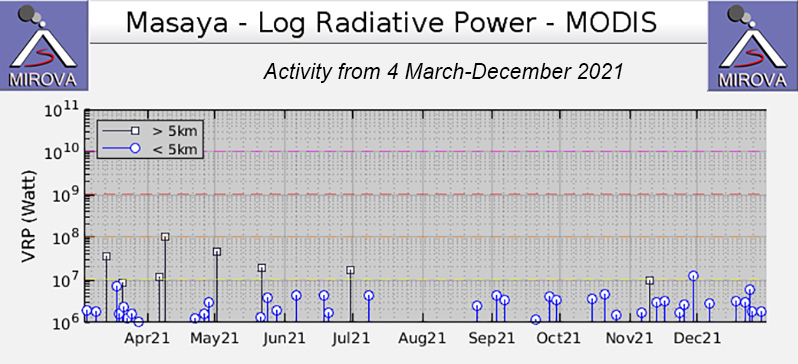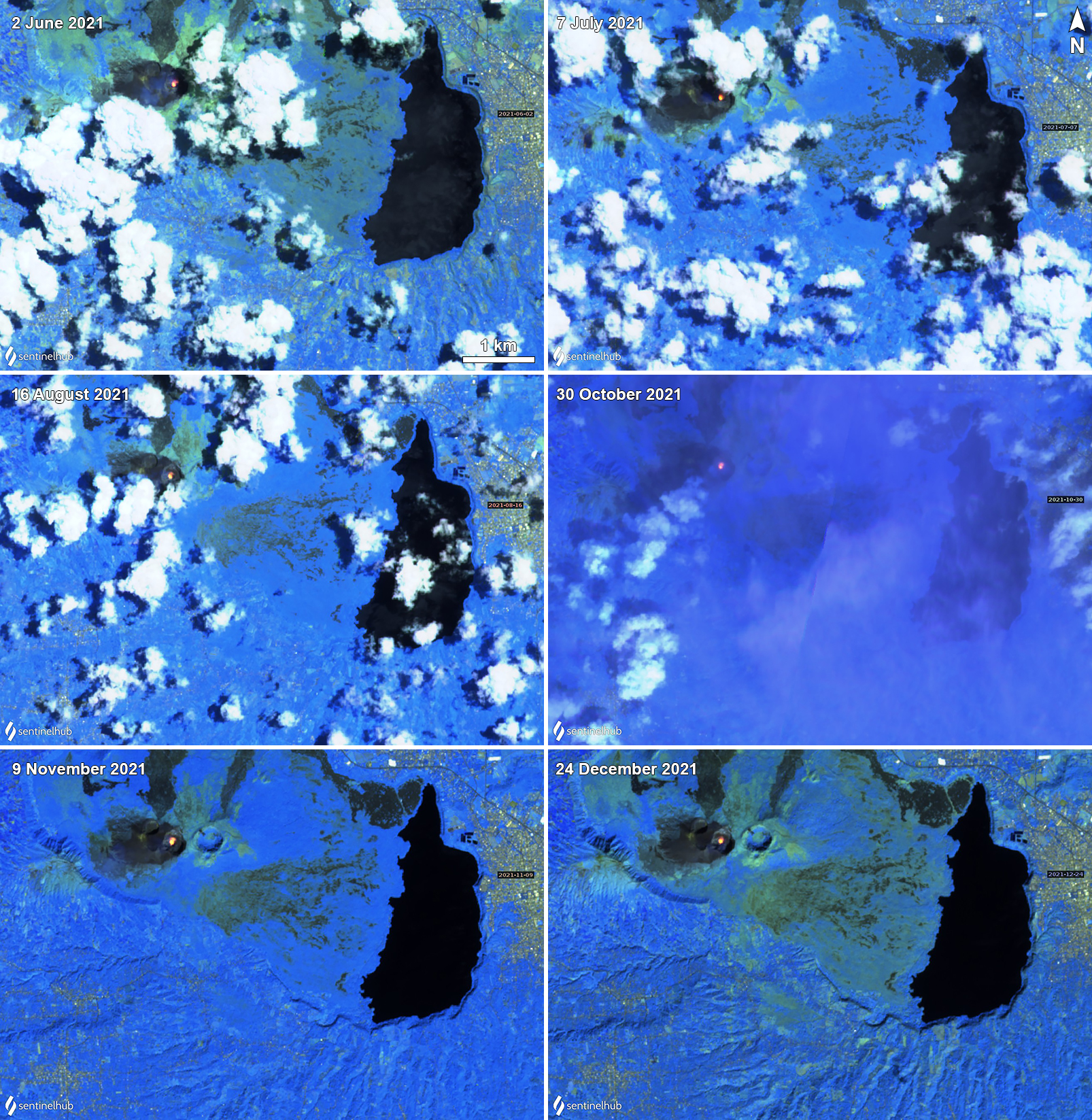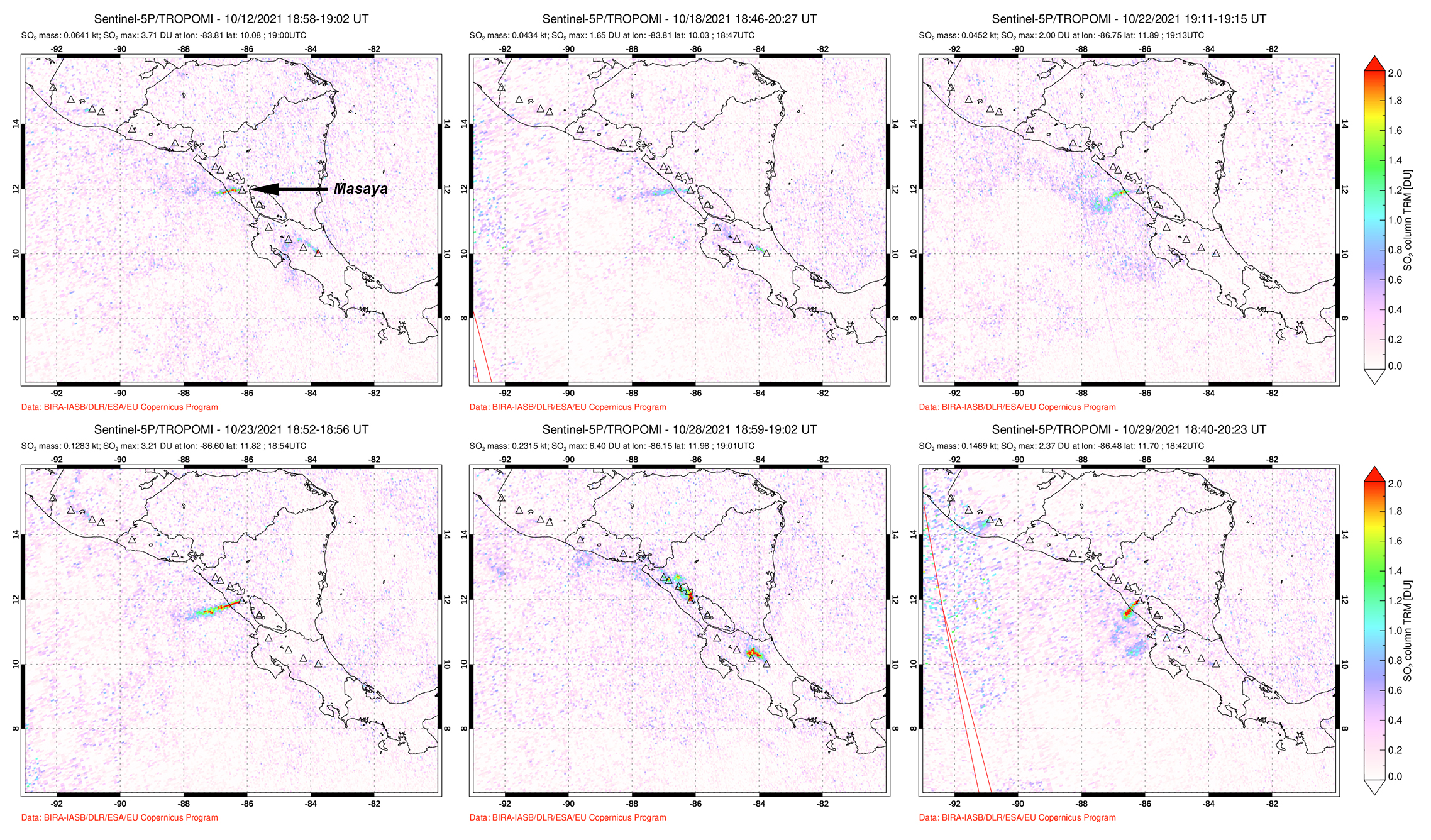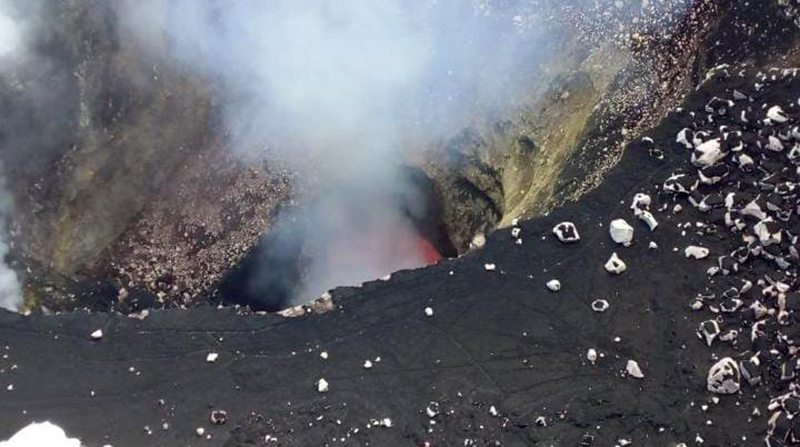Report on Masaya (Nicaragua) — January 2022
Bulletin of the Global Volcanism Network, vol. 47, no. 1 (January 2022)
Managing Editor: Edward Venzke.
Edited by Kadie L. Bennis.
Masaya (Nicaragua) Active lava lake and gas-and-steam emissions persist during June-December 2021
Please cite this report as:
Global Volcanism Program, 2022. Report on Masaya (Nicaragua) (Bennis, K.L., and Venzke, E., eds.). Bulletin of the Global Volcanism Network, 47:1. Smithsonian Institution. https://doi.org/10.5479/si.GVP.BGVN202201-344100
Masaya
Nicaragua
11.9844°N, 86.1688°W; summit elev. 594 m
All times are local (unless otherwise noted)
Masaya, located about 20 km SE of Managua, the capital of Nicaragua, contains a 6.5 x 11.5 km caldera with the Nindirí, San Pedro, San Juan, and the currently active Santiago craters. The current eruption period began in October 2015 and has recently consisted of an active lava lake and gas-and-steam emissions (BGVN 46:06). This report covers similar activity during June through December 2021, characterized by a declining lava lake level and gas-and-steam emissions, using information from the Instituto Nicareguense de Estudios Territoriales (INETER) and various satellite data.
MIROVA (Middle InfraRed Observation of Volcanic Activity) analysis of MODIS satellite data showed intermittent low-power thermal anomalies during June-December 2021, though a marked pause in thermal activity was noted during mid-July through late August (figure 100). This thermal activity was also visible in Sentinel-2 infrared satellite imagery, which was represented by a bright yellow-orange thermal anomaly in the Santiago crater’s lava lake (figure 101). Occasional gas-and-steam emissions were also detected drifting from the summit crater. Intermittent and small sulfur dioxide emissions that drifted generally W were observed notably during October based on data from the TROPOMI instrument on the Sentinel-5P satellite (figure 102).
Volcanism was relatively low throughout this reporting period. Seismic tremor continued to be detected, varying between 300 to 350 RSAM units; more than 8,700 low-frequency (LF) events had been recorded between January and June 2021. Sulfur dioxide measurements made on 22 June were an average of 839 tons/day, based on data on several transects using a mobile DOAS spectrometer. This measurement was lower compared to May (1,058 tons/day). During August, the rate of sulfur dioxide emissions decreased to 447 tons/day, a marked decrease from the July measurements of 1,400 tons/day. In addition to the decrease in gas-and-steam emissions, collapses along the crater walls of the lava lake were reported. On 13 August temperatures were determined based on thermal images; though the level of the lava lake had decreased, the temperature remained within the typical range of 500-800°C. Additionally, a fissure was observed on the NW wall of the Santiago crater.
During September, the rate of sulfur dioxide emissions was an average of 977 tons/day. Landslides on the walls of the Santiago crater toward the lava lake were observed, resulting in increased degassing, according to INETER. The level of the lava lake continued to decline, though incandescence was still visible (figure 103). In October, the average rate of sulfur dioxide emissions increased to 1,116 tons/day. Internal wall collapses continued during October and November, in addition to the declining lava lake level. The average rate of sulfur dioxide emissions was 1,037 tons/day in November. A single thermal alert was issued by the MODVOLC thermal algorithm on 29 November.
Geological Summary. Masaya volcano in Nicaragua has erupted frequently since the time of the Spanish Conquistadors, when an active lava lake prompted attempts to extract the volcano's molten "gold" until it was found to be basalt rock upon cooling. It lies within the massive Pleistocene Las Sierras caldera and is itself a broad, 6 x 11 km basaltic caldera with steep-sided walls up to 300 m high. The caldera is filled on its NW end by more than a dozen vents that erupted along a circular, 4-km-diameter fracture system. The Nindirí and Masaya cones, the source of observed eruptions, were constructed at the southern end of the fracture system and contain multiple summit craters, including the currently active Santiago crater. A major basaltic Plinian tephra erupted from Masaya about 6,500 years ago. Recent lava flows cover much of the caldera floor and there is a lake at the far eastern end. A lava flow from the 1670 eruption overtopped the north caldera rim. Periods of long-term vigorous gas emission at roughly quarter-century intervals have caused health hazards and crop damage.
Information Contacts: Instituto Nicaragüense de Estudios Territoriales (INETER), Apartado Postal 2110, Managua, Nicaragua (URL: http://www.ineter.gob.ni/); MIROVA (Middle InfraRed Observation of Volcanic Activity), a collaborative project between the Universities of Turin and Florence (Italy) supported by the Centre for Volcanic Risk of the Italian Civil Protection Department (URL: http://www.mirovaweb.it/); NASA Global Sulfur Dioxide Monitoring Page, Atmospheric Chemistry and Dynamics Laboratory, NASA Goddard Space Flight Center (NASA/GSFC), 8800 Greenbelt Road, Goddard, Maryland, USA (URL: https://so2.gsfc.nasa.gov/); Hawai'i Institute of Geophysics and Planetology (HIGP) - MODVOLC Thermal Alerts System, School of Ocean and Earth Science and Technology (SOEST), Univ. of Hawai'i, 2525 Correa Road, Honolulu, HI 96822, USA (URL: http://modis.higp.hawaii.edu/); Sentinel Hub Playground (URL: https://www.sentinel-hub.com/explore/sentinel-playground).





